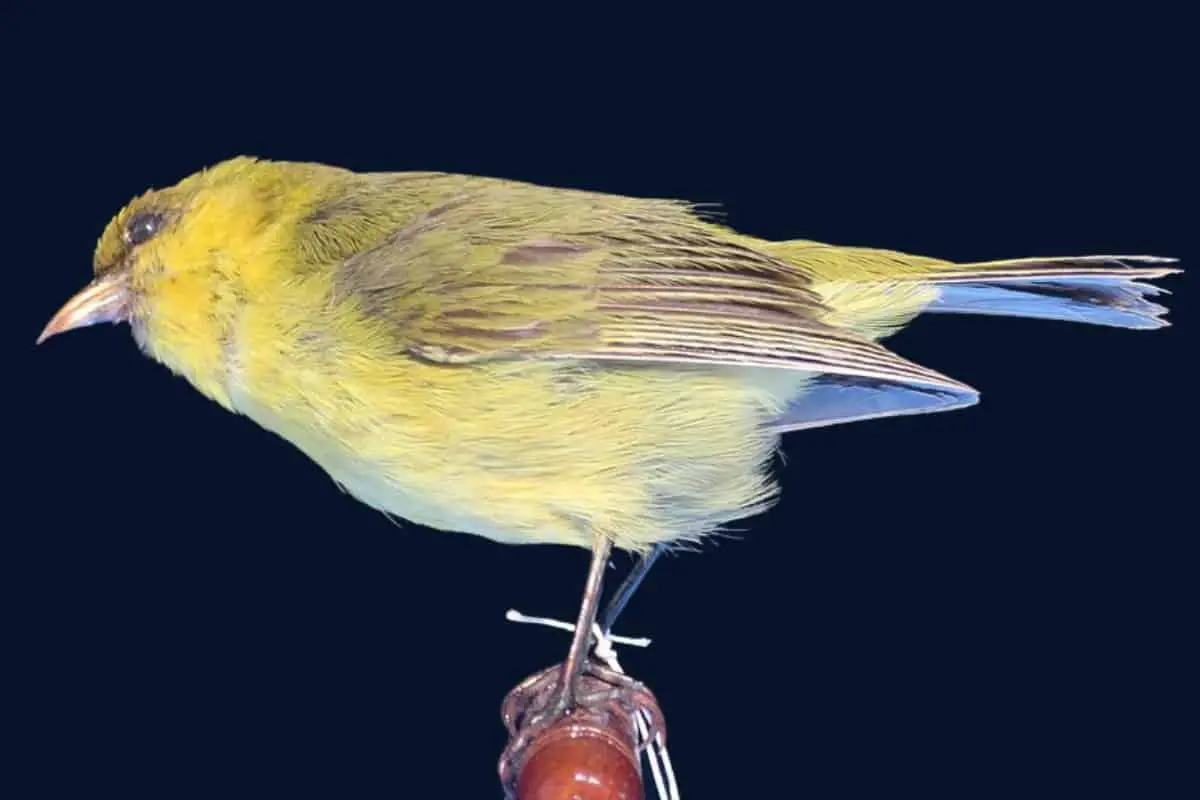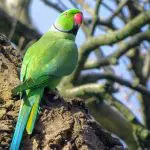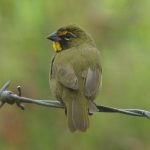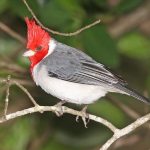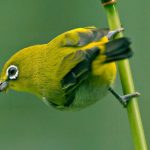Common Name: ʻAkekeʻe
Scientific Name: (Loxops caeruleirostris)| Size | Diet | Range in Hawaii | Status in Hawaii |
|---|---|---|---|
| 4.3 in. - 4.7 in. | insects and nectar | Kaua'i | Critically Endangered |
The ʻAkekeʻe (Loxops caeruleirostris) is a fascinating and unique bird species that is native to the island of Kauaʻi in Hawaii. With its distinctive blue and yellow plumage and playful behavior, this honeycreeper is a beloved sight in its natural habitat.
However, the species is currently listed as critically endangered due to habitat loss and other threats. In this article, we’ll explore the fascinating world of the ʻAkekeʻe, its role in Hawaii’s ecosystem, and the efforts being made to protect and preserve this incredible bird.
ʻAkekeʻe
Appearance
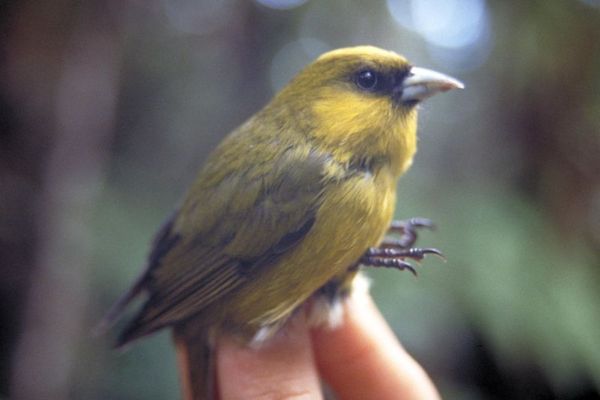
The ‘Akeke’e is a small bird species with a distinct appearance. It measures approximately 4.3 to 4.7 inches (11 to 12 centimeters) in length. The bird has a stocky body with a relatively short tail. It is known for its striking plumage, characterized by a vibrant yellow-green color on the head, back, and wings.
The underparts of the ‘Akeke’e are pale yellow, and it has a small black beak. This unique combination of colors and compact size makes the ‘Akeke’e easily recognizable in its native forest habitat on the island of Kaua’i.
Diet
The ‘Akeke’e has a specialized diet primarily focused on feeding on the nectar of native Hawaiian flowers. It has a long, curved bill that is perfectly adapted for reaching into flowers to extract nectar. This bird plays a vital role as a pollinator for these native plants, aiding in their reproduction.
In addition to nectar, the ‘Akeke’e also supplements its diet with small insects and arthropods, such as spiders and caterpillars. It forages actively among the vegetation, probing flowers and foliage for food.
Nesting
The ‘Akeke’e builds cup-shaped nests made of plant materials such as twigs, leaves, and moss. The nest is typically placed in the fork of a tree branch, providing a secure and sheltered location for breeding. Both male and female ‘Akeke’e participate in constructing the nest and incubating the eggs.
The breeding season of the ‘Akeke’e occurs during the spring and summer months. The female lays a clutch of two to three eggs, which are incubated for approximately 14 to 16 days by both parents. Once hatched, the parents take turns feeding and caring for the nestlings, providing them with a diet of regurgitated nectar and insects. The nestlings grow rapidly and fledge after about 17 to 21 days.
Behavior
The ‘Akeke’e exhibits interesting behavior in its foraging and social interactions. It is an active and agile bird, often observed darting among the forest foliage in search of food. The primary feeding behavior of the ‘Akeke’e is the extraction of nectar from native Hawaiian flowers using its specialized bill.
While foraging, the ‘Akeke’e plays a crucial role as a pollinator, transferring pollen from one flower to another as it seeks nectar. This behavior contributes to the reproduction and diversity of native plant species in its habitat.
The ‘Akeke’e is known to move in small family groups or pairs during foraging activities, and it may join mixed-species foraging flocks with other bird species. These flocks provide safety in numbers and potential advantages in locating food sources.
During breeding season, the ‘Akeke’e engages in courtship displays, including vocalizations and aerial chases. Males may also perform acrobatic flight displays to attract females.
Communication within the ‘Akeke’e population involves a variety of vocalizations, including melodic calls and chirps. These vocal signals are used for communication between individuals and potentially for territorial defense.
Habitat
The ‘Akeke’e’s habitat consists of native Hawaiian forests characterized by diverse vegetation, including native trees, shrubs, and understory plants. These forests are often characterized by misty and humid conditions, with a high rainfall regime.
Within its habitat, the ‘Akeke’e seeks out areas with abundant native flowering plants that provide a source of nectar. These native flowers play a crucial role in the bird’s diet and act as important foraging resources.
The intact native forest ecosystem provides the ‘Akeke’e with suitable nesting sites and shelter, as well as a variety of insects and arthropods for additional food sources. The presence of native tree species supports a healthy ecosystem, contributing to the overall well-being of the ‘Akeke’e and other native species.
Range
The ‘Akeke’e is a bird species that is exclusively found on the island of Kaua’i in the Hawaiian archipelago. It primarily inhabits higher elevations above 1000 meters. The bird’s range is centered on the island’s interior, particularly in the Alaka’i Plateau and Koke’e State Park.
While it was once considered fairly common within its range, population declines have resulted in a contraction of its distribution. Recent observations indicate that small numbers of ‘Akeke’e can still be found in the interior Alaka’i Plateau of Koke’e State Park, emphasizing the importance of protecting and preserving its habitat in this limited range.
Conservation Status
The ‘Akeke’e is classified as an endangered species due to its critically low population numbers and the ongoing threats it faces. The primary factors contributing to its endangered status include habitat loss, degradation, and the impacts of invasive species.
Conservation efforts are focused on protecting and restoring the ‘Akeke’e’s habitat by implementing measures to control invasive species, preserving native forests, and establishing protected areas. Research plays a crucial role in understanding the bird’s biology and behavior, aiding in the development of targeted conservation strategies.
Interesting Facts
1. Unique vocalizations
The ‘Akeke’e communicates through a variety of vocalizations, including melodic calls and chirps. These vocal signals are used for communication between individuals and potentially for territorial defense.
2. Important Pollinator
As the ‘Akeke’e feeds on nectar, it plays a vital role in pollinating native Hawaiian flowers. This behavior contributes to the reproduction and diversity of plant species within its habitat.
3. Vibrant plumage
This bird has striking plumage, with a vibrant yellow-green color on the head, back, and wings. Its underparts are pale yellow, creating a beautiful contrast.
4. Unique bill
The ‘Akeke’e has a specialized bill adapted for feeding on nectar. Its long, curved bill allows it to reach deep into flowers to extract nectar, making it an important pollinator.
Frequently Asked Questions
1. What is the role of the ‘Akeke’e in the ecosystem?
The ‘Akeke’e is primarily found in the high-elevation forests of Kaua’i, particularly within the Alaka’i Plateau and Koke’e State Park.
2. Why is the ‘Akeke’e endangered?
The ‘Akeke’e is endangered due to habitat loss, degradation, and the impacts of invasive species, which have led to significant population declines.
3. How long do ‘Akeke’e typically live?
The lifespan of the ‘Akeke’e in the wild is not precisely known. However, similar bird species within the genus Loxops have been observed to live for up to 5-10 years.
